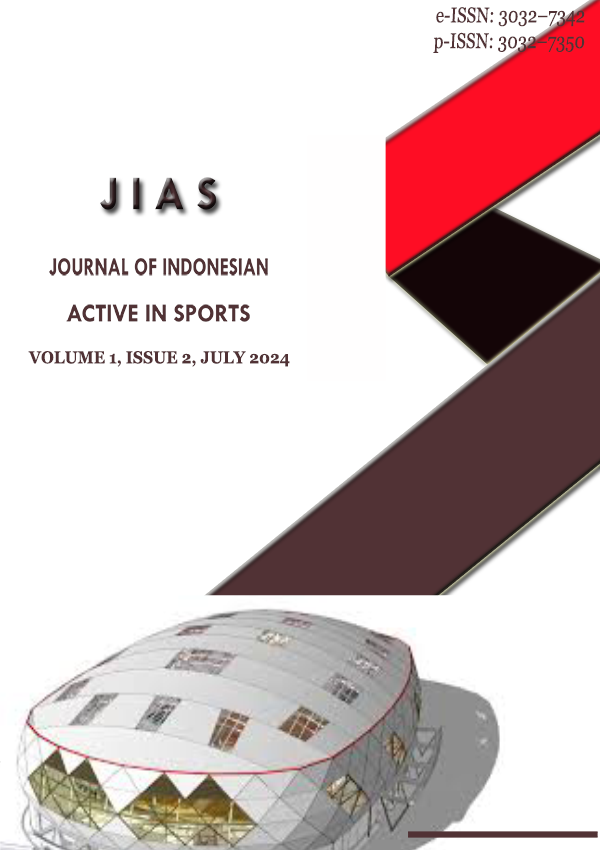Contribution of Lateral Bound and Triceps Dips Exercises to the Repulsion Results of Men in North Padang Lawas Regency
DOI:
https://doi.org/10.24114/jias.v1i2.49513Abstract
The proficiency in the sport of shot put is contingent upon the harmonious integration of strength, power, and technique. Notwithstanding its significance, athletes at Pembina Prestasi club in North Padang Lawas have demonstrated suboptimal outcomes, necessitating a targeted intervention to enhance their performance. The objective of study was to investigate the impact of lateral bound and tricep dip exercises on the performance of male athletes at Pembina Prestasi Club in the discipline of shot put. A pre-test and post-test experimental study was conducted on six male shot put athletes. The intervention comprised lateral bound and triceps dip exercises, conducted thrice weekly for 18 sessions over a six-week period. The efficacy of intervention was evaluated by measuring the participants' shot put performance before and after the intervention. The data were analyzed using descriptive statistics, normality tests, and paired sample t-tests. The results demonstrated a statistically significant enhancement in shot put performance subsequent to the intervention. The mean throwing distance increased from 6.40 meters to 7.74 meters, accompanied by a reduction in performance variability. The frequency distribution of performance categories exhibited a positive shift, with 66.33% of participants transitioning to the "Good" category following the intervention. A statistically significant difference was observed between the pre-test and post-test scores (p = 0.025). The implementation of lateral bound and tricep dip exercises effectively enhanced shot put performance among the studied athletes. The intervention not only improved throwing distances but also led to more consistent performances. Further research should explore these exercises with larger sample sizes and over extended periods. The integration of advanced technologies for more precise measurements and investigation of personalized training approaches based on individual athlete characteristics are recommended. Additionally, studies examining the long-term effects of these interventions and their applicability across different athlete demographics could further contribute to optimizing shot put.References
Al Ardha, M. A., Nurhasan, N., Supriyanto, C., Wulandari, F. Y., Yang, C. B., Lin, J. H., . . . Rizki, A. Z. (2024). Sports Biomechanics Research on the Hammer Throw: Systematic Review. Retos, 54, 248-254.
Beattie, K., Kenny, I. C., Lyons, M., & Carson, B. P. (2014). The Effect of Strength Training on Performance in Endurance Athletes. Sports Medicine, 44(6), 845-865. doi:https://doi.org/10.1007/s40279-014-0157-y
Giulianotti, R. (2015). Sport: A critical sociology (2 ed.). Cambridge: Polity Press.
Haugen, T., Seiler, S., Sandbakk, Ø., & Tønnessen, E. (2019). The Training and Development of Elite Sprint Performance: an Integration of Scientific and Best Practice Literature. Sports Med Open, 5(1), 44. doi:https://doi.org/10.1186/s40798-019-0221-0
Kyle, D. G. (2014). Greek Athletic Competitions A Companion to Sport and Spectacle in Greek and Roman Antiquity (pp. 17-35). Chichester: Wiley-Blackwel.
Miranda-Oliveira, P., Correia, D., Vieira, M., Ruben, R., & Fernandes, O. (2021). Influence of the gender in the rotational shot-put, in Athletics' elite athletes Advances and Current Trends in Biomechanics (1 ed., pp. 139-143). Porto: CRC Press.
Schofield, M., Cronin, J. B., Macadam, P., & Hébert-Losier, K. (2022). Rotational shot put: a phase analysis of current kinematic knowledge. Sports Biomechanics, 21(3), 278-296. doi:10.1080/14763141.2019.1636130
Sitepu, I. D. (2018). Manfaat permainan bola basket untuk anak usia dini. Jurnal Prestasi, 2(3), 27-33. doi:https://doi.org/10.24114/jp.v2i3.10129
Soares, D., Lourenço, J., Silva, A. F., & Flôres, F. (2023). Influence of Maximal Strength on Bench Press and Trunk Rotation in Adapted Shot-put: A Pilot Investigation. Exerc Sci, 32(2), 194-199. doi:https://doi.org/10.15857/ksep.2022.00584
Steele, J., Fisher, J., Skivington, M., Dunn, C., Arnold, J., Tew, G., . . . Winett, R. (2017). A higher effort-based paradigm in physical activity and exercise for public health: making the case for a greater emphasis on resistance training. BMC Public Health, 17(1), 300. doi:https://doi.org/10.1186/s12889-017-4209-8
WÅ‚odarczyk, M., Adamus, P., ZieliÅ„ski, J., & Kantanista, A. (2021). Effects of Velocity-Based Training on Strength and Power in Elite Athletes”A Systematic Review. International Journal of Environmental Research and Public Health, 18(10), 5257. doi:https://doi.org/10.3390/ijerph18105257
Zaras, N. D., Stasinaki, A.-N. E., Methenitis, S. K., Krase, A. A., Karampatsos, G. P., Georgiadis, G. V., . . . Terzis, G. D. (2016). Rate of Force Development, Muscle Architecture, and Performance in Young Competitive Track and Field Throwers. The Journal of Strength & Conditioning Research, 30(1), 81-92. doi:https://doi.org/10.1519/JSC.0000000000001048
Downloads
Published
How to Cite
Issue
Section
License
Copyright (c) 2024 Yan Indra Siregar & Indah Lestari Nasution

This work is licensed under a Creative Commons Attribution-ShareAlike 4.0 International License.












